Design and Test of Embedded Reconfigurable Mode Converter Based on Spontaneous Deformable Materials
Abstract
:1. Introduction
2. Methods
2.1. Concept, Theory and Design of The Proposed Mode Converter
2.2. Numerical Demonstrations of Performance
3. Results
4. Conclusions
Author Contributions
Funding
Institutional Review Board Statement
Informed Consent Statement
Data Availability Statement
Conflicts of Interest
References
- Iatrou, C.T.; Whaley, D.R.; Kern, S.; Thumm, M.; Tran, M.Q.; Möbius, A.; Nickel, H.-U.; Norajitra, P.; Wien, A.; Tran, T.M.; et al. Feasibility study of the eu home team on a 170GHz 1MW CW gyrotron for ECH on ITER. Int. J. Infrared Millim. Waves 1995, 16, 1129–1158. [Google Scholar] [CrossRef]
- Danly, B.G.; Blank, M.; Calame, J.P.; Levush, B.; Nguyen, K.T.; Pershing, D.E.; Parker, R.K.; Felch, K.L.; James, B.G.; Borchard, P.; et al. Development and testing of a high-average power, 94-GHz gyroklystron. IEEE Trans. Plasma Sci. 2000, 28, 713–726. [Google Scholar]
- Hosseini, S.J.; Oraizi, H. A TEM-TE11 mode converter antenna like a pelican beak. IET Microw. Antennas Propag. 2020, 14, 934–942. [Google Scholar] [CrossRef]
- Rahkala, M.; Suntio, T.; Kalliomaki, K. Effects of switching frequency modulation on EMI performance of a converter using spread spectrum approach. IEEE Appl. Power Electron. Conf. Expo. 2002, 1, 93–99. [Google Scholar]
- Yao, J.; Wang, S.; Zhao, H. Measurement techniques of common mode currents, voltages, and impedances in a flyback converter for radiated emi diagnosis. IEEE Trans. Electromagn. Compat. 2019, 61, 1997–2005. [Google Scholar] [CrossRef]
- Salmanogli, A.; Gokcen, D. Entanglement sustainability improvement using optoelectronic converter in quantum radar (interferometric object-sensing). IEEE Sens. J. 2021, 21, 9054–9062. [Google Scholar] [CrossRef]
- Huang, C.Y.; Lin, C.H.; Chen, Y.H.; Huang, Y.C. Electro-Optic Ti:PPLN Waveguides as Efficient Optical Wavelength Filters and Mode Polarization Converters. In Proceedings of the Conference on Lasers and Electro-Optics, Baltimore, MD, USA, 6–11 May 2007. [Google Scholar]
- Karppanen, M.; Sippola, M.; Suntio, T. Impact of remote sensing on converter stability and performance. In Proceedings of the 2007 European Conference on Power Electronics & Applications, Aalborg, Denmark, 2–5 September 2007. [Google Scholar]
- Yeddulla, M.; Tantawi, S.; Guo, J.; Dolgashev, V. An Analytical Design and Analysis Method for a High-Power Circular to Rectangular Waveguide Mode Converter and Its Applications. IEEE Trans. Microw. Theory Tech. 2009, 57, 1516–1525. [Google Scholar] [CrossRef]
- Tantawi, S.G.; Nantista, C.D.; Dolgashev, V.A.; Pearson, C.; Nelson, J.; Jobe, K.; Chan, J.; Fant, K.; Frisch, J.; Atkinson, D. High-power multimode X-band rf pulse compression system for future linear colliders. Phys. Rev. Accel. Beams 2005, 8, 42002. [Google Scholar] [CrossRef]
- Nantista, C. An Alternate Dual-Moded DLDS Utilizing the TE01 and TE02 Modes. In Proceedings of the XX International Linac Conference, Monterey, CA, USA, 21–25 August 2000; pp. 757–759. [Google Scholar]
- Tantawi, S.G.; Nantista, C.D.; Dolgashev, V.A.; Pearson, C.; Nelson, J.; Jobe, K.; Chan, J.; Fant, K.; Frisch, J.; Atkinson, D. On-chip two-mode division multiplexing using tapered directional coupler-based mode multiplexer and demultiplexer. Opt. Express 2013, 21, 10376–10382. [Google Scholar]
- Ohana, D.; Levy, U. Mode conversion based on dielectric metamaterial in silicon. Lasers Electro-Opt. IEEE 2014, 22, 27617–27631. [Google Scholar] [CrossRef] [PubMed]
- Hao, L.J.; Xiao, R.; Shi, Y.; Dai, P.; Zhao, Y.; Liu, S.; Lu, J.; Chen, X. Efficient TE-Polarized Mode-Order Converter Based on High-Index-Contrast Polygonal Slot in a Silicon-on-Insulator Waveguide. IEEE Photonics J. 2019, 11, 99. [Google Scholar] [CrossRef]
- Chen, D.G.; Xiao, X.; Wang, L.; Yu, Y.; Liu, W.; Yang, Q. Low-loss and fabrication tolerant silicon mode-order converters based on novel compact tapers. Opt. Express 2015, 23, 11152–11159. [Google Scholar] [CrossRef]
- Huang, Y.; Xu, G.; Ho, S.-T. An ultracompact optical mode order converter. IEEE Photonics Technol. Lett. 2006, 18, 2281–2283. [Google Scholar] [CrossRef]
- Guan, H.; Ma, Y.; Shi, R.; Novack, A.; Tao, J.; Fang, Q.; Lim, A.E.-J.; Lo, G.-Q.; Baehr-Jones, T.; Hochberg, M. Ultracompact silicon-on-insulator polarization rotator for polarization-diversified circuits. Opt. Lett. 2014, 39, 4703–4706. [Google Scholar] [CrossRef]
- Liu, V.; Miller, D.A.B.; Fan, S. Ultra-compact photonic crystal waveguide spatial mode converter and its connection to the optical diode effect. Opt. Express 2012, 20, 28388–28397. [Google Scholar] [CrossRef]
- Chen, G.; Kang, J.U. Waveguide mode converter based on two-dimensional photonic crystals. Opt. Lett. 2005, 30, 1656–1658. [Google Scholar] [CrossRef]
- Frandsen, L.H.; Elesin, Y.; Frellsen, L.F.; Mitrovic, M.; Ding, Y.; Sigmund, O.; Yvind, K. Topology optimized mode conversion in a photonic crystal waveguide fabricated in silicon-on-insulator material. Opt. Express 2014, 22, 8525–8532. [Google Scholar] [CrossRef] [PubMed]
- Matsumoto, S.; Ohta, I.; Fukada, K.; Kawai, T.; Iio, K.I.; Kashiwa, T. A TE10-TE20 mode transducer utilizing a right-angled corner and its application to a compact H-plane out-of-phase power divider. In Proceedings of the Microwave Conference, 2009, APMC 2009, Asia Pacific IEEE, Nagoya, Japan, 30 June 2010; pp. 1008–1011. [Google Scholar]
- Zhang, Q.; Yuan, C.W.; Liu, L. Theoretical Design and Analysis for TE20-TE10 Rectangular Waveguide Mode Converters. IEEE Trans. Microw. Theory Tech. 2012, 60, 1018–1026. [Google Scholar] [CrossRef]
- Shu, G.; Cai, Z.; Li, Y.; Liu, G.; He, W. Wideband rectangular te to ten0 mode converters for terahertz-band high-order overmoded planar slow-wave structures. IEEE Trans. Electron. Devices 2020, 67, 1259–1265. [Google Scholar] [CrossRef]
- Jouguet, M. Effect of curvature on the propagation of electromagnetic waves in guides of circular cross sections. Cables Transm. 1947, 1, 133–153. [Google Scholar]
- Shu, G.; Qian, Z.; He, W. Design and measurement of an h-band rectangular TE10 to TE20 mode converter. IEEE Access 2020, 8, 37242–37249. [Google Scholar] [CrossRef]
- Zhao, P.; Wang, Q.; Deng, J. A Novel Broadband Rectangular Waveguide TE 01–TE 20 Mode Converter. IEEE Microw. Wirel. Compon. Lett. A Publ. IEEE Microw. Theory Tech. Soc. 2018, 28, 747–749. [Google Scholar] [CrossRef]
- Xu, Y.; Peng, T.; Sun, M.; Luo, Y.; Wang, J.; Jiang, W.; Liu, G.; Wu, Z. Design and test of broadband rectangular waveguide te 10 to circular waveguide te 21 and te 01 mode converters. IEEE Trans. Electron. Devices 2019, 66, 3573–3579. [Google Scholar] [CrossRef]
- Yu, X.; Kim, J.Y.; Fujita, M.; Nagatsuma, T. Efficient mode converter to deep-subwavelength region with photonic-crystal waveguide platform for terahertz applications. Opt. Express 2019, 27, 28707–28721. [Google Scholar] [CrossRef]
- Dong, W.; Sha, X.; Yan-Wei, C.; Fen, Q. Design of a metallic photonic crystal high power microwave mode converter. Acta Phys. Sin. -Chin. Ed. 2014, 63, 018401. [Google Scholar] [CrossRef]
- Yao, C.H.; Wang, Z.; Wang, H.; He, Y.; Zhang, Y.; Su, Y. Multi-mode conversion via two-dimensional refractive-index perturbation on a silicon waveguide. arXiv 2019, arXiv:1911.10786. [Google Scholar]
- Huang, C.; Huang, C. Theoretical analysis of mode conversion by refractive-index perturbation based on a single tilted slot on a silicon waveguide. Opt. Express 2020, 28, 18986–18999. [Google Scholar] [CrossRef]
- Leonhardt, U. Optical conformal mapping. Science 2006, 312, 1777–1780. [Google Scholar] [CrossRef]
- Pendry, J.B.; Schurig, D.; Smith, D.R. Controlling electromagnetic fields. Science 2006, 312, 1780–1782. [Google Scholar] [CrossRef]
- Xiao, R.; Shi, Y.; Li, J.; Dai, P.; Zhao, Y.; Li, L.; Lu, J.; Chen, X. On-chip mode converter based on two cascaded Bragg gratings. Opt. Express 2019, 27, 1941–1957. [Google Scholar] [CrossRef]
- Li, Z.Y.; Kim, M.-H.; Wang, C.; Han, Z.; Shrestha, S.; Overvig, A.C.; Lu, M.; Stein, A.; Agarwal, A.M.; Lončar, M.; et al. Controlling propagation and coupling of waveguide modes using phase-gradient metasurfaces. Nat. Nanotechnol. 2017, 12, 675–683. [Google Scholar] [CrossRef]
- Dai, D.; Wang, J.; Shi, Y. Silicon mode (de)multiplexer enabling high capacity photonic networks-on-chip with a single-wavelength-carrier light. Opt. Lett. 2013, 38, 1422–1424. [Google Scholar] [CrossRef]
- Guo, Z.; Wu, S.; Xiao, J. Compact and flexible mode-order converter based on mode transitions composed of asymmetric tapers and subwavelength gratings. J. Light. Technol. 2021, 39, 5563–5572. [Google Scholar] [CrossRef]
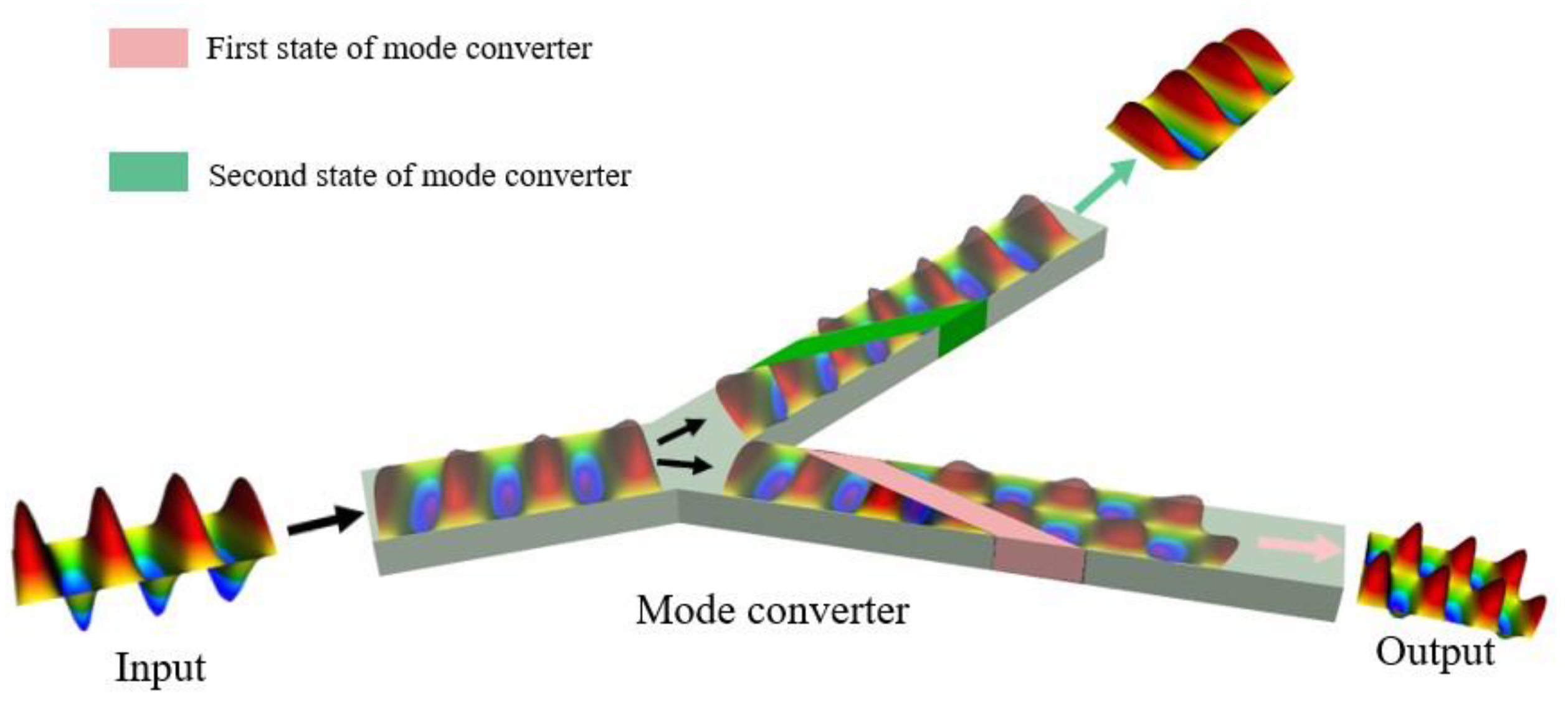

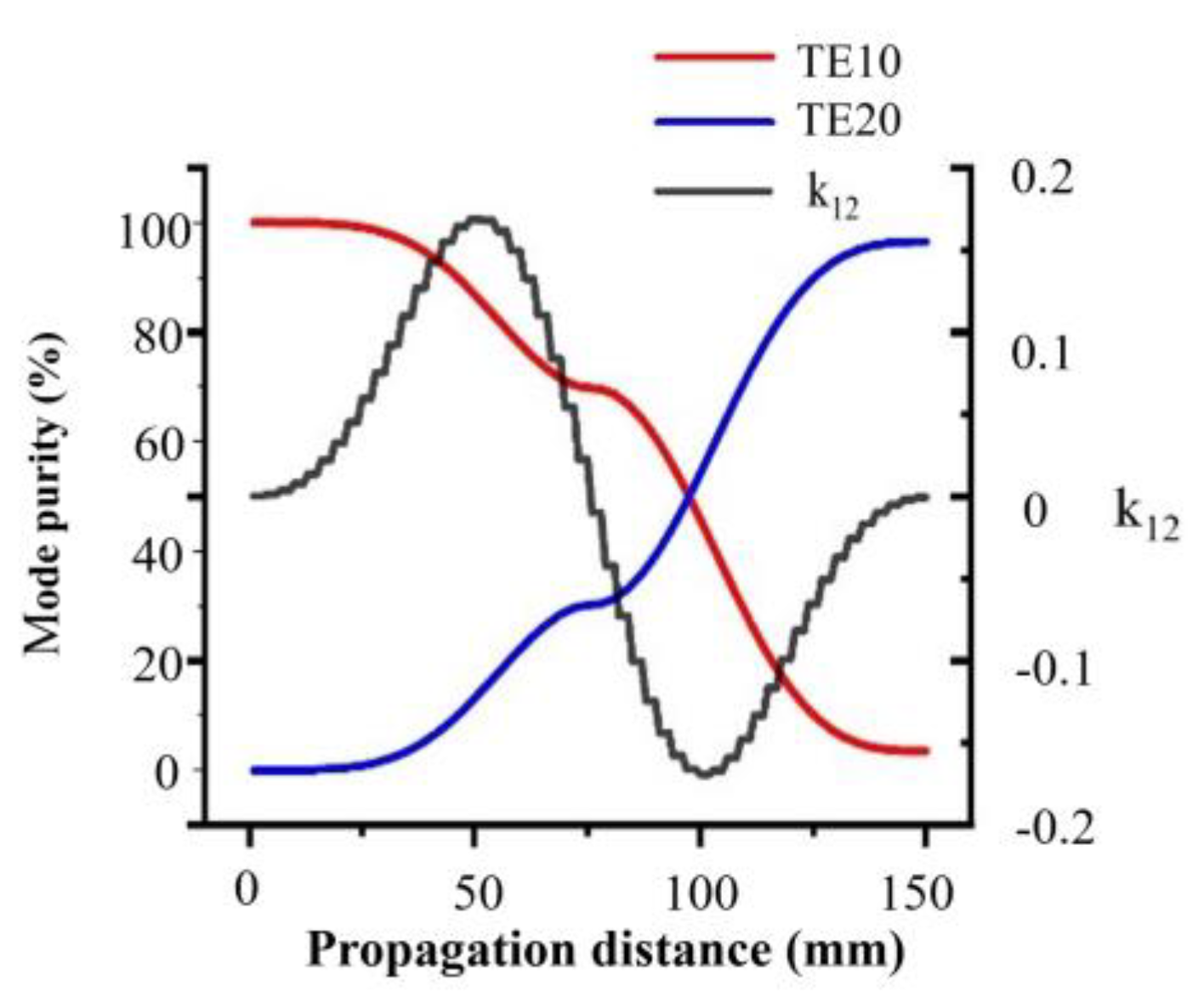
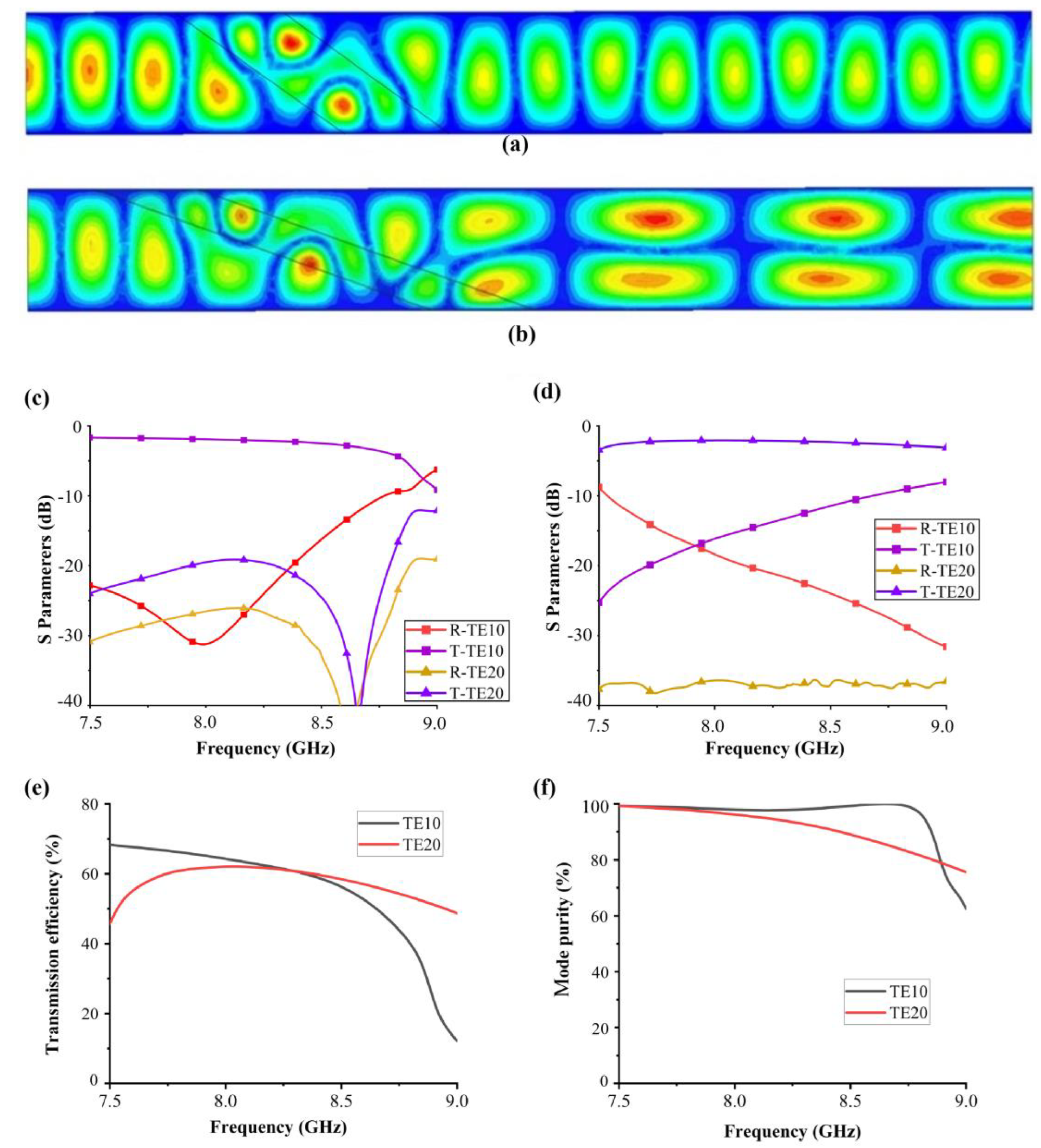
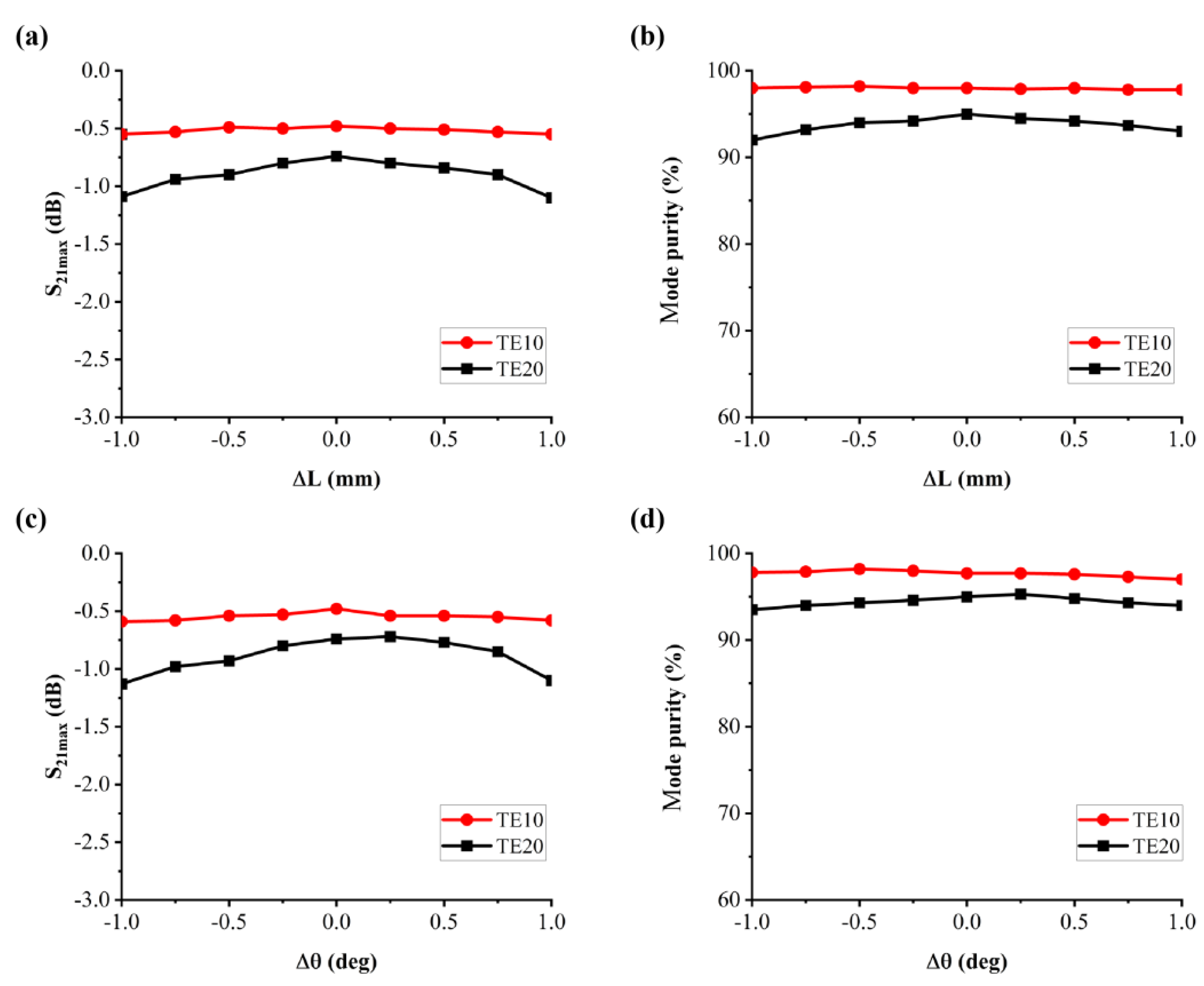
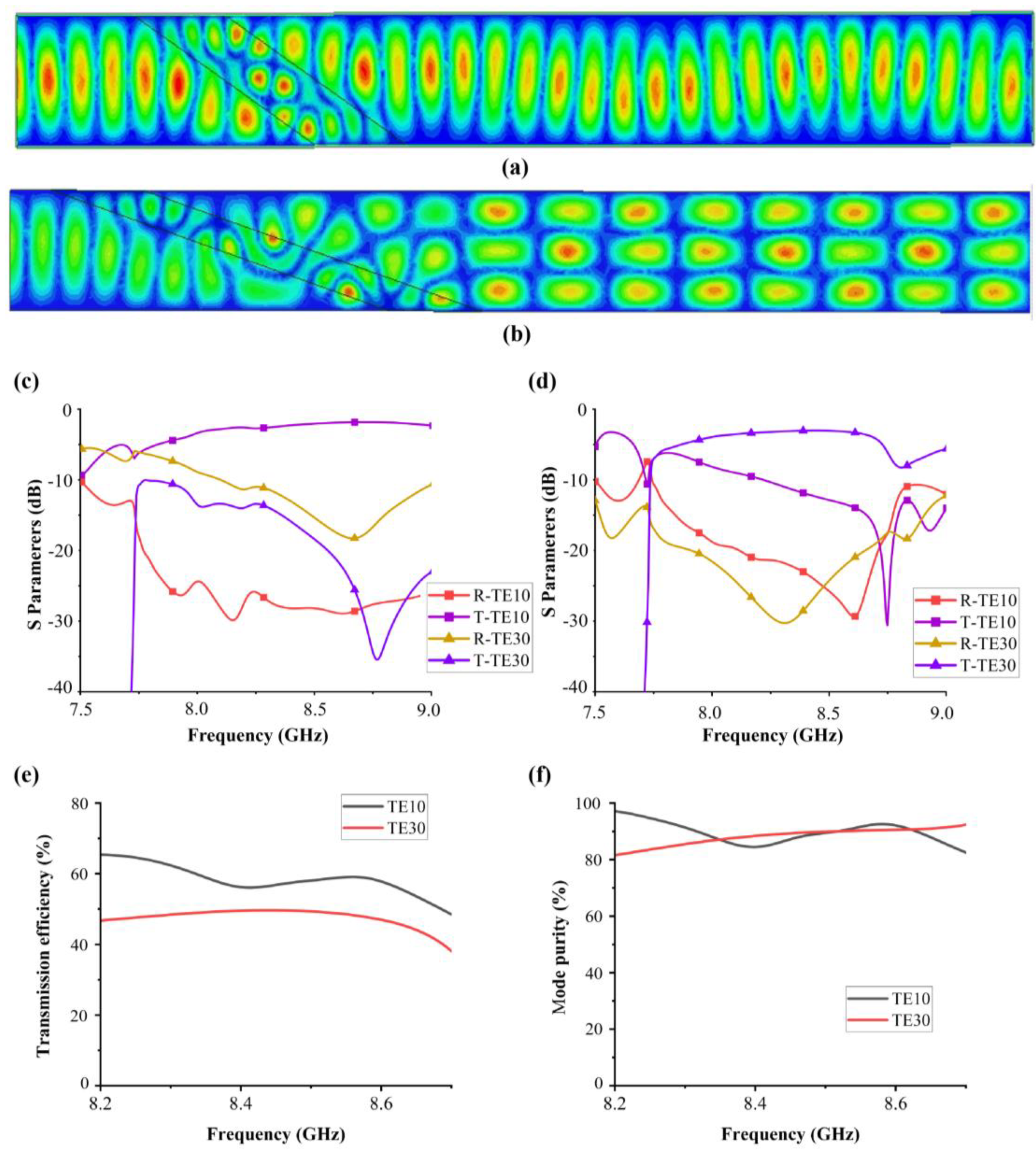


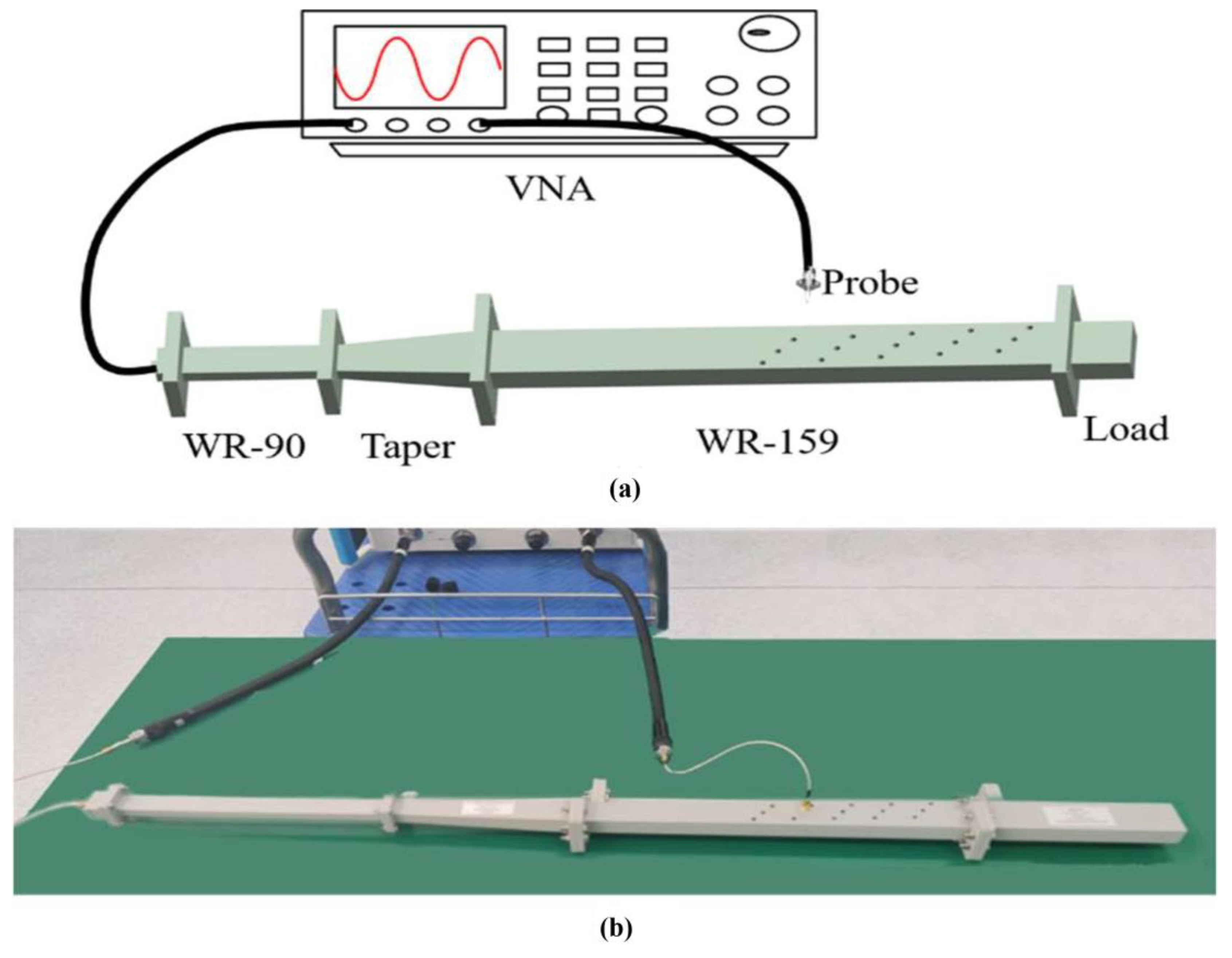
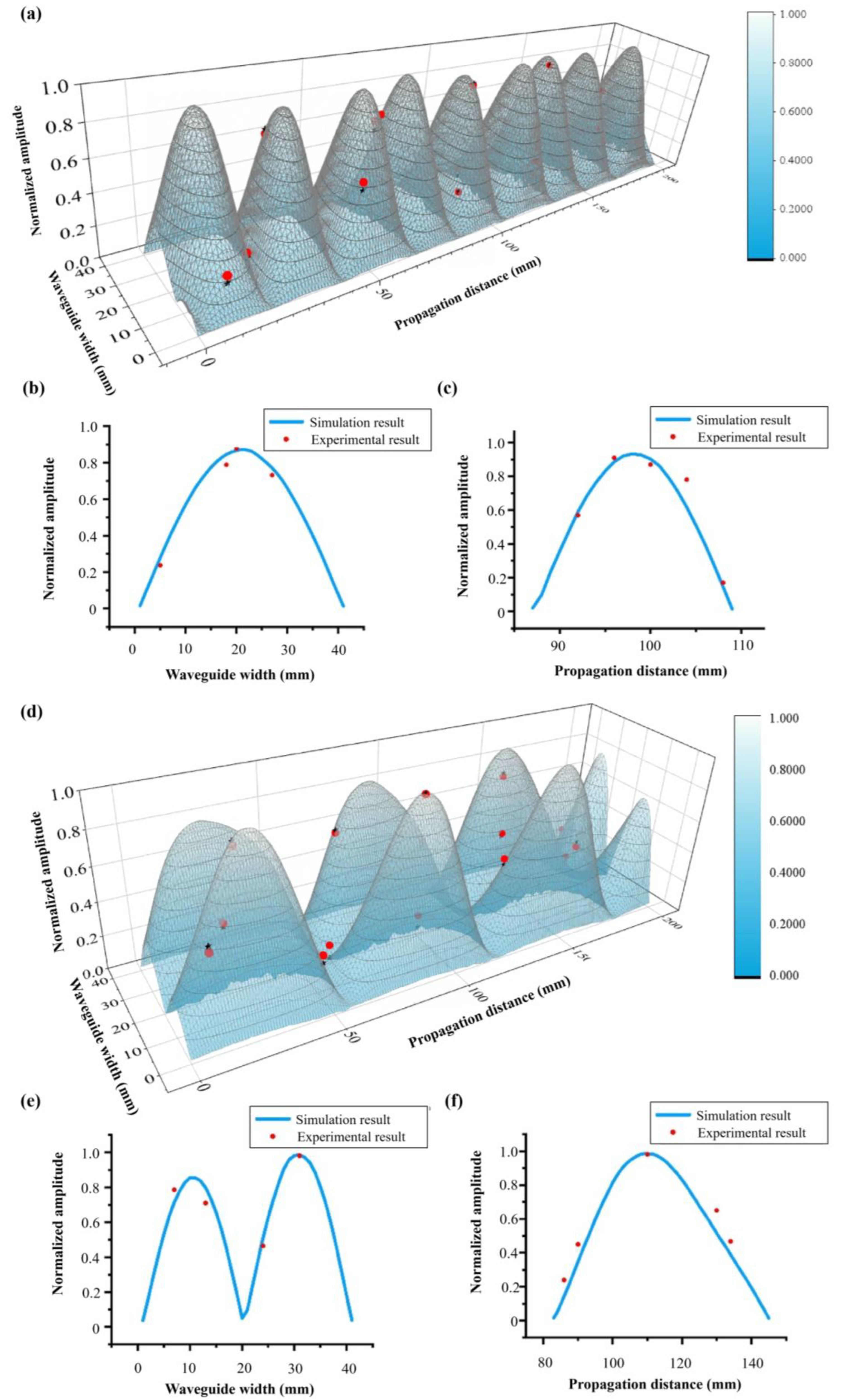
| Function | (mm) | (mm) | (mm) | |
|---|---|---|---|---|
| 40.386 | 36 | 118.81 | 26° | |
| 40.386 | 36 | 157.43 | 18.4° |
| Function | (mm) | (mm) | (mm) | |
|---|---|---|---|---|
| 58.17 | 36 | 140.94 | 29° | |
| 58.17 | 36 | 220.28 | 17° |
Disclaimer/Publisher’s Note: The statements, opinions and data contained in all publications are solely those of the individual author(s) and contributor(s) and not of MDPI and/or the editor(s). MDPI and/or the editor(s) disclaim responsibility for any injury to people or property resulting from any ideas, methods, instructions or products referred to in the content. |
© 2023 by the authors. Licensee MDPI, Basel, Switzerland. This article is an open access article distributed under the terms and conditions of the Creative Commons Attribution (CC BY) license (https://creativecommons.org/licenses/by/4.0/).
Share and Cite
Wang, S.; Zhang, Y.; Yi, J. Design and Test of Embedded Reconfigurable Mode Converter Based on Spontaneous Deformable Materials. Materials 2023, 16, 6420. https://doi.org/10.3390/ma16196420
Wang S, Zhang Y, Yi J. Design and Test of Embedded Reconfigurable Mode Converter Based on Spontaneous Deformable Materials. Materials. 2023; 16(19):6420. https://doi.org/10.3390/ma16196420
Chicago/Turabian StyleWang, Shixiong, Yilin Zhang, and Jianjia Yi. 2023. "Design and Test of Embedded Reconfigurable Mode Converter Based on Spontaneous Deformable Materials" Materials 16, no. 19: 6420. https://doi.org/10.3390/ma16196420
APA StyleWang, S., Zhang, Y., & Yi, J. (2023). Design and Test of Embedded Reconfigurable Mode Converter Based on Spontaneous Deformable Materials. Materials, 16(19), 6420. https://doi.org/10.3390/ma16196420





